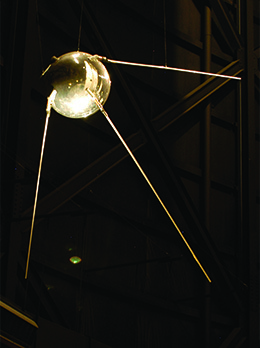| << Chapter < Page | Chapter >> Page > |
View this short instructional film made in 1951 that teaches elementary school children what to do in the event an atomic bomb is dropped. Why do you think officials tried to convey the message that a nuclear attack was survivable?
Government and industry allocated enormous amounts of money to the research and development of more powerful weapons. This investment generated rapid strides in missile technology as well as increasingly sensitive radar. Computers that could react more quickly than humans and thereby shoot down speeding missiles were also investigated. Many scientists on both sides of the Cold War, including captured Germans such as rocket engineer Werner von Braun, worked on these devices. An early success for the West came in 1950, when Alan Turing, a British mathematician who had broken Germany’s Enigma code during World War II, created a machine that mimicked human thought. His discoveries led scientists to consider the possibility of developing true artificial intelligence.
However, the United States often feared that the Soviets were making greater strides in developing technology with potential military applications. This was especially true following the Soviet Union’s launch of Sputnik ( [link] ), the first manmade satellite, in October 1957. In September 1958, Congress passed the National Defense Education Act, which pumped over $775 million into educational programs over four years, especially those programs that focused on math and science. Congressional appropriations to the National Science Foundation also increased by $100 million in a single year, from $34 million in 1958 to $134 million in 1959. One consequence of this increased funding was the growth of science and engineering programs at American universities.

In the diplomatic sphere, Eisenhower pushed Secretary of State John Foster Dulles to take a firmer stance against the Soviets to reassure European allies of continued American support. At the same time, keenly sensing that the stalemate in Korea had cost Truman his popularity, Eisenhower worked to avoid being drawn into foreign wars. Thus, when the French found themselves fighting Vietnamese Communists for control of France’s former colony of Indochina, Eisenhower provided money but not troops. Likewise, the United States took no steps when Hungary attempted to break away from Soviet domination in 1956. The United States also refused to be drawn in when Great Britain, France, and Israel invaded the Suez Canal Zone following Egypt’s nationalization of the canal in 1956. Indeed, Eisenhower, wishing to avoid conflict with the Soviet Union, threatened to impose economic sanctions on the invading countries if they did not withdraw.
Although the Eisenhower years were marked by fear of the Soviet Union and its military might, they were also a time of peace and prosperity. Even as many Americans remained mired in poverty, many others with limited economic opportunities, like African Americans or union workers, were better off financially in the 1950s and rose into the ranks of the middle class. Wishing to build the secure life that the Great Depression had deprived their parents of, young men and women married in record numbers and purchased homes where they could start families of their own. In 1940, the rate of homeownership in the United States was 43.6 percent. By 1960, it was almost 62 percent. Many of these newly purchased homes had been built in the new suburban areas that began to encircle American cities after the war. Although middle-class families had begun to move to the suburbs beginning in the nineteenth century, suburban growth accelerated rapidly after World War II.

Notification Switch
Would you like to follow the 'U.s. history' conversation and receive update notifications?